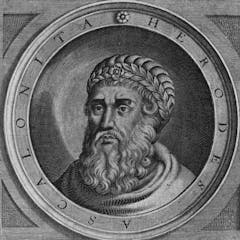
Articles on Ancient history
Displaying 1 - 20 of 98 articles

The ancient evidence suggests Alexander was particularly close with one of his male companions. But how close exactly?

Historians know a fair bit about Herod the Great, the king of Judea at the time of Jesus’ birth.

Modern reactions to unidentified aerial phenomena (UAPs – what you might think of as UFOs) are similar to those of thousands of years ago.

There was no one type of slavery in ‘biblical’ or ‘ancient’ societies, given how varied they were. But much of what historians know about slavery during those eras is horrific.

In the largest study of its kind, researchers have used DNA from a 6,700-year-old cemetery in France to reconstruct the lives of everyday Neolithic people.

Machu Picchu is now an iconic tourist destination in Peru – but it was once a royal palace that pulled people from all corners of the Inca empire.

Despite wine’s centrality to the everyday life of the Romans, the ancient sources continuously attest it was a problematic drink when consumed by women.

Researchers examined whether kissing is an innate human activity or whether its origins are relatively recent.

The gate has been built on the site of an actual Roman gateway, thought to date to the invasion of Britain in AD 43.

The gaping maws and great belch of the Norse ‘hafgufa’ may well have been a humpback whale simply engaging in trap-feeding.

Evidence in Earth’s natural archives, from tree rings to seafloor sediments, points to one trend. Some climate models suggest another.

There’s a long history in our society of period pain being played down, or just considered “normal”. But there’s plenty of evidence in the historical records that women have always experienced it.

The new ‘docuseries’ makes grand claims about our ice age ancestors. Here’s why you should proceed with caution.

The UN estimates the global population will pass 8 billion people on Nov. 15, 2022. From the Stone Age to today, here’s how things spiraled out of control.

Pompeii is remembered as a place of surprising liberality – but the ‘masturbating man’ is probably a far less lurid tale than assumed.

A patchwork of Roman laws (including Rome’s complex murder laws) sought to address coercive and violent behaviour

Increasing rainfall and degrading peatland are threatening archaeological artefacts buried in UK land.

The huppû, from modern-day Syria were celebrated athletes, trained in specialist academies, touring to foreign kingdoms, and facing the threat of arts funding cuts.

From 1996 to 2001, the Taliban outlawed almost all forms of art while looting and destroying museums. With their resurgence, Australia must strengthen measures to stop trafficking of antiquities.

History isn’t just learning facts. Students learn about the past by researching information and synthesising it to form an evidence-based argument. This skill is useful for a range of careers.
